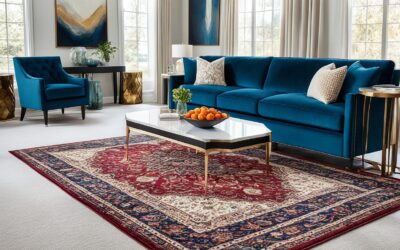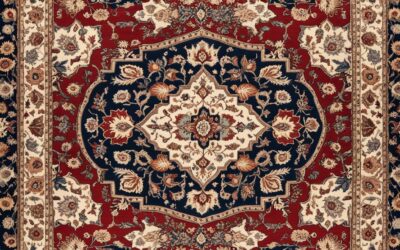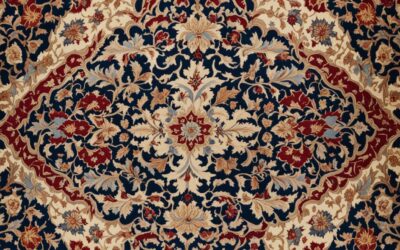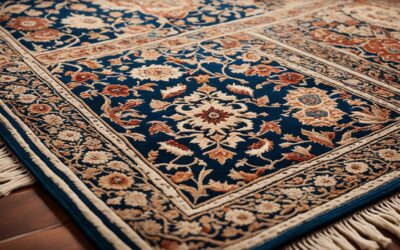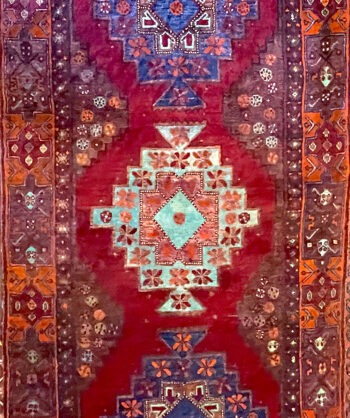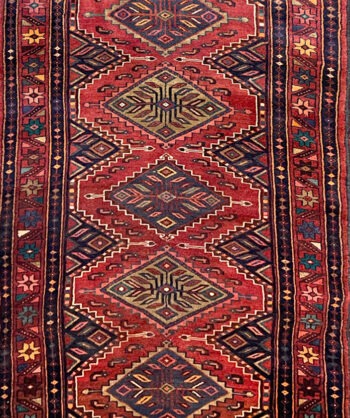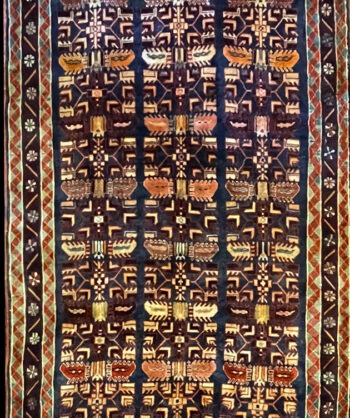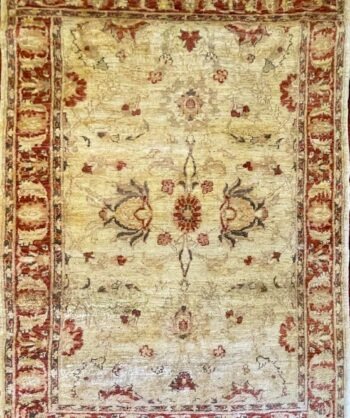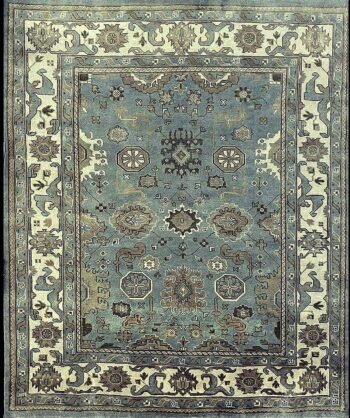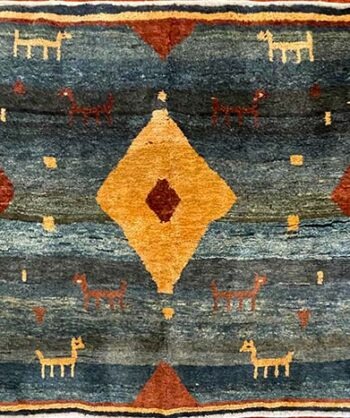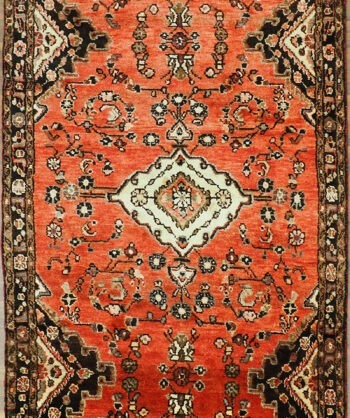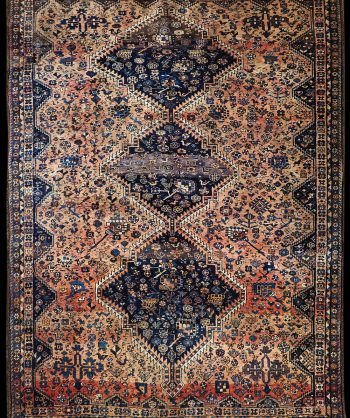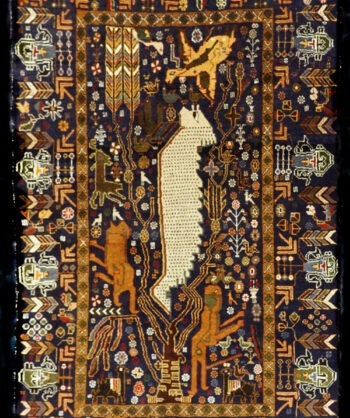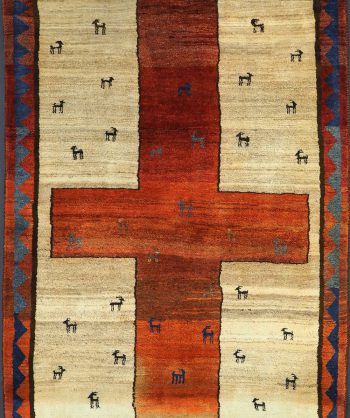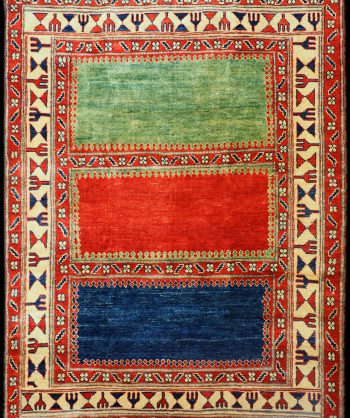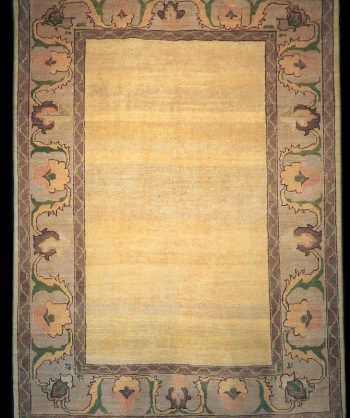Table of Contents
The tradition and history of Persian rugs show their amazing craftsmanship and art. They are more than just floor coverings. Persian rugs stand for both honour and are passed down as family treasures.
Persian rugs go back to the Achaemenid Empire, about 550 B.C. They started with simple mats made from bamboo and plant stalks. Soon, they became luxurious items for kings and palaces.
The Pazyryk carpet is an exciting find, from the 5th century BC. It was discovered in Siberia. This ancient carpet is the oldest known pile-woven one, showing amazing ancient skills.
Even though we’re not completely sure how early Persian rugs were made, we know they were important. They were more than decorations. They were gifts of friendship, wealth symbols, and status markers.
Over time, Persian rug making got better and better. Today, they’re known for their detailed patterns, bright colors, and the effort put into each one.
Key Takeaways:
- Persian rugs have a history dating back to the Achaemenid Empire.
- The world’s oldest known pile-woven carpet, the Pazyryk carpet, is a stunning example of early Persian rug craftsmanship.
- Persian rugs have held immense cultural and economic significance, acting as symbols of wealth and prestige.
- Authentic Persian carpets are cherished for their intricate designs and exceptional craftsmanship.
- The evolution of Persian rug weaving techniques and designs has contributed to their enduring allure and popularity.
Evolution of Persian Rug Weaving Techniques and Designs
Persian rugs show a deep cultural history through their designs and methods. The Persians have been making rugs for thousands of years. They’ve passed their weaving skills from parent to child.
Long ago, nomadic groups in Central Asia made sturdy rugs. They used wool that was spun by hand and then woven. This made strong rugs fit for homes.
In the 8th century, when Islam spread, Azerbaijan became a big rug-making center. This time saw rugs becoming more detailed with Islamic patterns. They started using beautiful, natural plant and insect dyes.
Even tough times, like when the Mongols invaded, didn’t stop Persian rug production. Skilled workers kept the weaving traditions alive. Today’s Persian rugs are a tribute to these ancient crafts.
Persian rugs are famous for their detailed designs. You’ll see beautiful flowers or shapes in many of their patterns. People use different weaving ways to make these, like knotting or embroidery.
From 1501-1732, the Safavid Dynasty was a big time for Persian rugs. Cities like Tabriz and Kerman led in making beautiful rugs. These rugs marked the Golden Age of Persian Carpets.
To really see the beauty in Persian rugs, we should learn about their making. This includes their long history, special weaving ways, and the incredible designs that have inspired many.
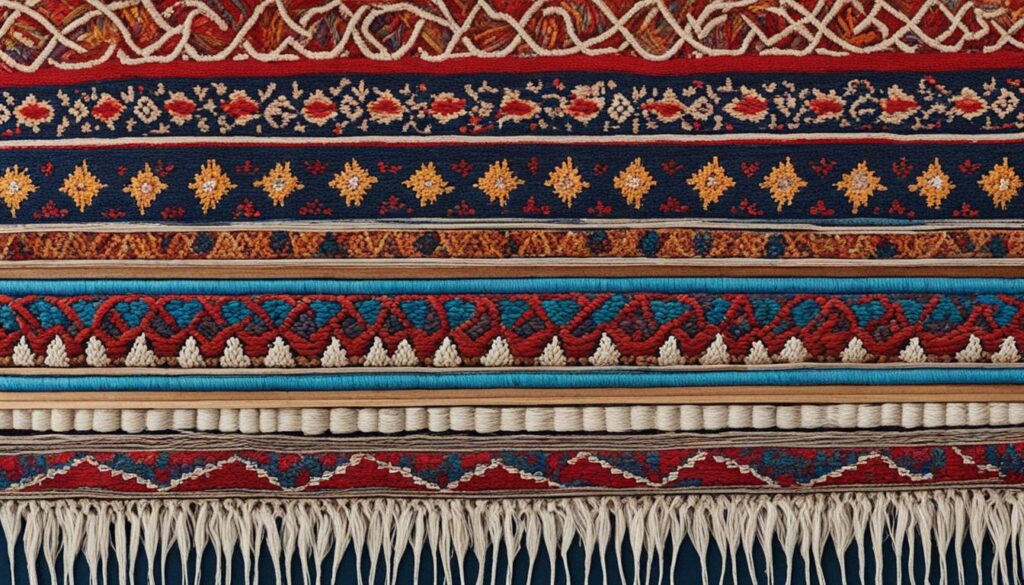
Key Features of Persian Rugs:
- Intricate floral and geometric Persian rug patterns
- Various weaving techniques such as pile weaving, flat-weaving, and embroidery/textile
- Use of natural dyes to create vibrant colors
- Durable construction with hand-spun wool fibers
- Reflects the rich cultural heritage of Persia
Significance of Persian Rugs in Society and Culture
Persian rugs are more than just beautiful. They hold a deep meaning in Persian society and culture. They stand for luxury and diplomacy, not just as floor coverings.
In the past, countries would gift Persian carpets to each other. It showed how rich they were and helped form friendships. Owning one showed off your wealth and power.
Over time, Persian rugs became a key part of cultural and artistic life. They were not just useful but also a way to show creativity.
After the Parthian Empire came the Sasanian Empire. This era lasted over 400 years and helped spread the use of carpet weaving. It also brought new designs for floor coverings.
The rugs from this time mixed many cultural influences. They had patterns and colors from Byzantium, Anatolia, and Persia. These mixtures made the rugs stand out.
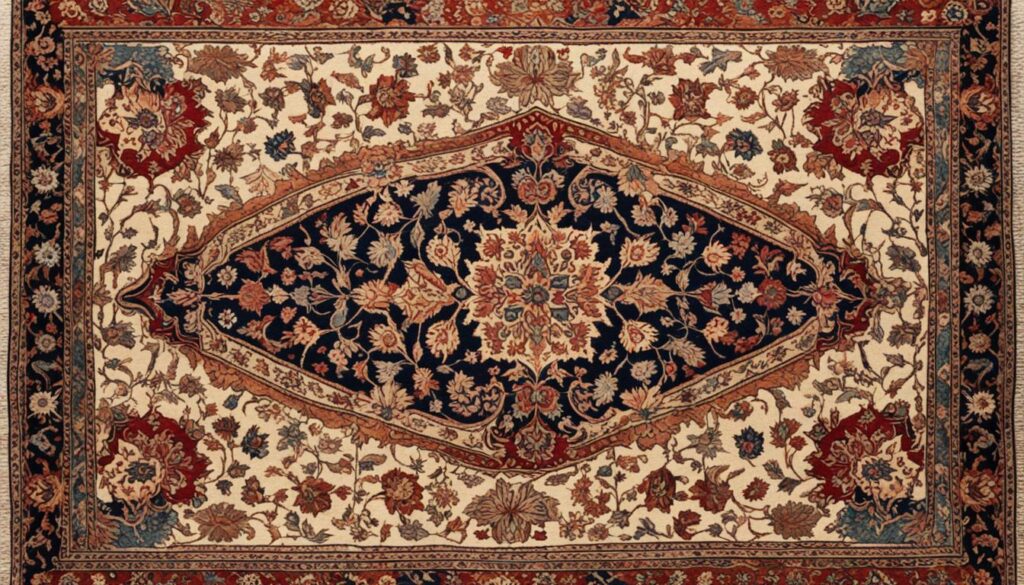
Antique Persian rugs were often found in the homes of the rich and powerful. For them, the rugs were a symbol of their social status and good taste. Their detailed designs showed the care that went into making them.
They were also important parts of family traditions. Passed down through generations, they kept stories alive. They made homes feel welcoming and celebrated Persian culture.
Even today, Persian rugs are highly valued. They are sought after by collectors and those who love history. In modern interiors or cultural displays, these rugs show the beauty of Persian artistic traditions and heritage.
The Golden Age of Persian Rugs – Safavid Dynasty
From 1501 to 1732, the Safavid Dynasty made amazing Persian rugs. It was a time of great art and culture in Iran. These efforts caused a rebirth in rug making. Leaders like Shah Abbas I started special workshops. They hired the best weavers to make spectacular carpets. These rugs were seen in grand places and traded as valuable goods. Cities like Kerman and Kashan became famous for rug making then.
Safavid rugs had pretty flower designs and bold colors. Rugs like the Ardabil Carpet and the Sheikh Safi Carpet stand out. They are known for their beauty and skill.
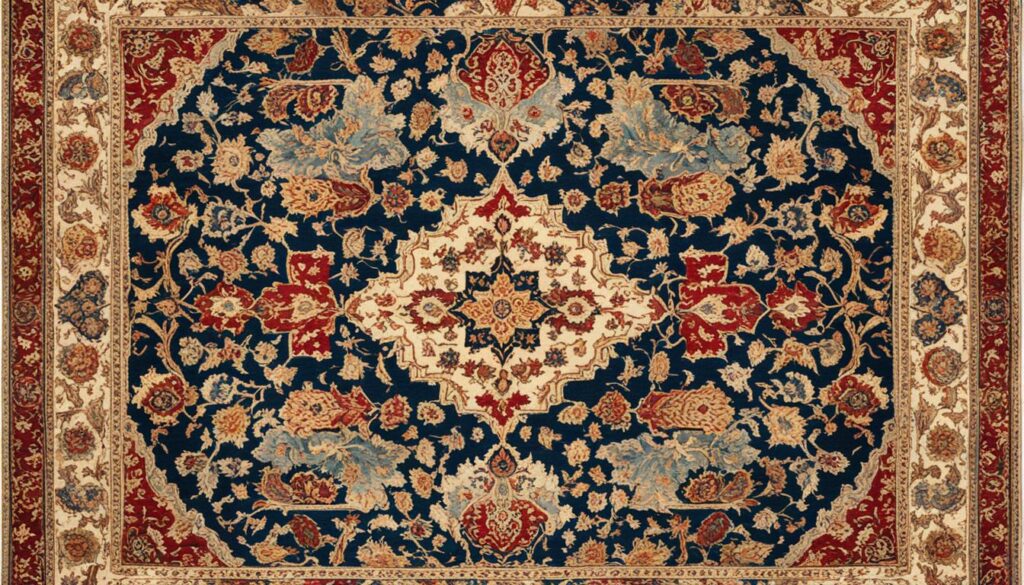
| Characteristic | Description |
|---|---|
| Designs | Safavid rugs showed off beautiful Persian designs. There were flowers, shapes, and medallions all over them. |
| Patterns | The patterns on Persian rugs were very fancy then. They had twisty lines, special flower shapes, and even pictures on them. |
| Craftsmanship | People at the Safavid Dynasty made rugs really well. They used the best materials, dyeing, and tying. This made their rugs last long and feel great. |
| Colors | Safavid rugs were full of bright and beautiful colors. You saw deep reds, blues, and gold colors a lot. These colors made the rugs look warm and stunning. |
Spread of Rug-Making and Influences Across the Islamic World
From the 8th to the 14th century, the Islamic Golden Age sparked the spread of rug-making. It traveled across the Islamic world and even further, leaving its mark on the rich tradition of Oriental carpet weaving.
The empire’s growth through both trade and conquest spread the beauty of authentic Persian carpets. These carpets carried not just materials and designs, but also the complex and exquisite techniques used in their creation.
This era of cultural sharing and art advancement opened up new horizons for rug-making. Regions like Anatolia, the Caucasus, and North Africa began adopting these traditions. Trade routes, including the Silk Road, played a vital role in this exchange of ideas, materials, and designs.
Rug designs started to feature geometric motifs, flowers, and beautiful writing. These elements showcased the varied and rich artistic heritage of the Islamic world. With skill and imagination, Oriental carpets transformed into stunning pieces of art.
The Ottoman Empire, from the 14th to the early 20th century, had a lasting effect on rug-making. It covered lands across three continents, influencing rug production and trade greatly. Notably, places like Usak, Bergama, and Konya became well-known for their unique rug styles, adding to the brilliance of Oriental carpets.
By adopting the Persian tradition, these areas and their people played a major role in the evolution of rug-making. Together, they formed a web of traditions, connecting cultural dots across different times and areas.
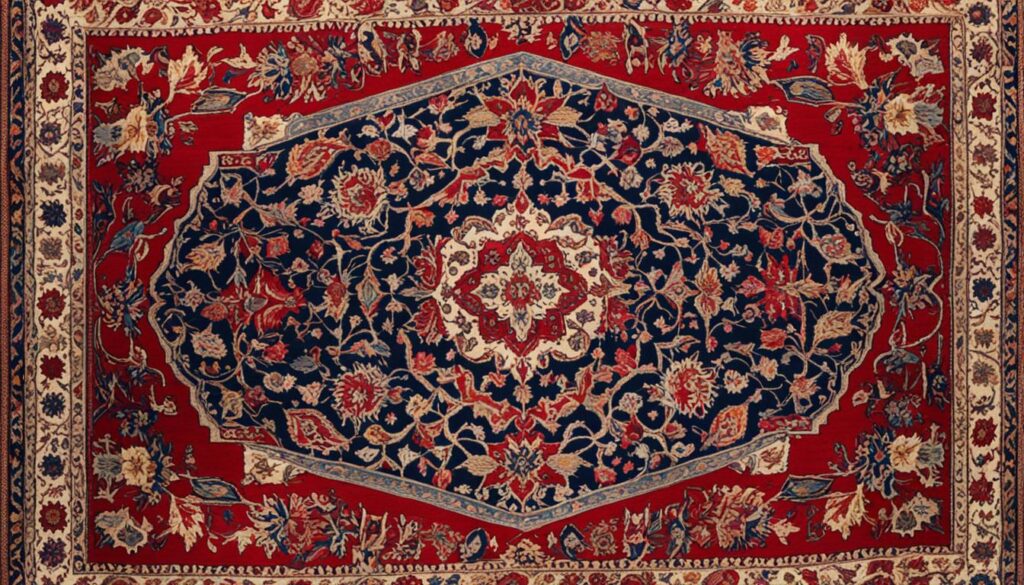
Legacy of Ottoman Rugs and Turkish Rug Influence
The history of Oriental carpets is filled with stories from many cultures and people. The story of Ottoman rugs is an important chapter in this tale. These rugs, made in the Ottoman Empire, showed a unique blend of design and craft.
In the Ottoman Empire, regions had their own rug-making traditions. Places like Usak, Bergama, and Konya were famous for their rugs. They combined geometric and curvilinear designs. The rugs used bright colors and stylized motifs, making them beautiful.
The Ottoman court supported skilled weavers and craftsmen. It encouraged the making of these beautiful rugs. These rugs show a mix of Persian and Ottoman styles, creating something new.
The empire’s location between Europe and Asia helped its rug trade grow. Ottoman rugs soon became a symbol of luxury and high status. They were seen in noble homes and collector’s palaces around the world.
Ottoman rugs were known for their unique Turkish knot. This knot made the rugs stand out from others. It added to their special look and quality.
Even today, Ottoman rugs are highly valued. They are admired by collectors, designers, and enthusiasts worldwide. Their design and craftsmanship are deeply rooted in the traditions of Turkish rug-making.
The story of Ottoman rugs shows how different cultures can influence each other. It’s a beautiful example of how art and craft connect us. These rugs have made a lasting impact on the world of decoration and textile design.
| Distinctive Features of Ottoman Rugs and Turkish Rug Influence | |
|---|---|
| Regional rug-making styles from Usak, Bergama, and Konya | Combination of geometric and curvilinear designs |
| Stylized motifs and vibrant color palette | Ottoman court’s patronage of the arts |
| Strategic location facilitating rug trade and export | Usage of Turkish knot in rug weaving |
Conclusion
Handmade Persian and Oriental rugs have a long, rich history of thousands of years. These rugs are known for their detailed patterns and bright colors. They are not just beautiful but are also very important culturally and economically. Originating in ancient Persia, they have evolved into a timeless art. This art still captures hearts around the world today.
Each handwoven Persian rug shows the amazing skills of ancient craftsmen. They used special weaving techniques only known to them. These rugs share stories of the places they were made, showing their history, culture, and traditions. Whether as family heirlooms or new treasures, they are loved for their top quality and beauty.
The Persian rug tradition shaped rug-making in the Islamic world. The Golden Age of the Safavid Dynasty was a big part of this journey. The craft spread and mixed with other cultures, leading to a variety of designs. Their beauty and unique stories have made these rugs a must-have in design and by collectors.
In today’s world, where machines often make things, Persian rugs are true symbols of human artistry and imagination. These rugs are timeless pieces, greatly loved for their beauty and narratives. The Persian rug tradition is set to carry on. It will keep mesmerizing future generations, preserving an extraordinary art heritage and culture.
FAQ
What is the history of Persian rugs?
Persian rugs go way back to 550 B.C. through 350 B.C. These rugs were first made from bamboo and plant stalks. Later, they became luxurious items fit for kings and their palaces.
What are the traditional weaving techniques used in Persian rugs?
The methods include pile weaving, flat-weaving, and embroidery/textile. These have been perfected over many years. Skills were often handed down from one generation to the next.
What is the significance of Persian rugs in society and culture?
In ancient times, Persian rugs stood for prestige, luxury, and even diplomacy. They were prized diplomatic gifts. Also, they played a vital part in the region’s identity and culture.
What was the Golden Age of Persian rugs?
Durin the Safavids’ rule from 1501 to 1732, Persian rugs reached their peak. Royal workshops attracted the best weavers. The carpets made were spectacular and adorned important buildings. They also became valuable for trade.
How did rug-making spread across the Islamic world?
Durin the Islamic Golden Age, from the 8th to the 14th centuries, rug making spread. This was through trade and conquest. The Silk Road played a big role in sharing ideas. This helped grow the tradition of rug making.
How did Ottoman rugs influence rug production and trade?
The Ottomans were key in shaping rug production and trade. Styles from places like Usak, Bergama, and Konya featured unique designs. These included geometric and curvilinear shapes. Ottoman rugs are highly valued for their craftsmanship and history.
Where can I find authentic Persian carpets?
Look for Persian carpets in trusted rug stores, at special auctions, or with known rug dealers. Always check the rug’s authenticity and quality before buying.


